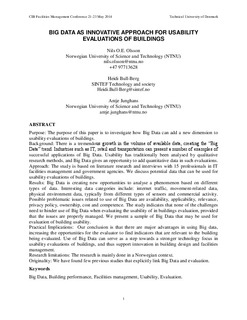| dc.contributor.author | Olsson, Nils | |
| dc.contributor.author | Bull-Berg, Heidi | |
| dc.contributor.author | Junghans, Antje | |
| dc.date.accessioned | 2015-01-30T07:59:01Z | |
| dc.date.accessioned | 2016-06-22T08:41:46Z | |
| dc.date.available | 2015-01-30T07:59:01Z | |
| dc.date.available | 2016-06-22T08:41:46Z | |
| dc.date.issued | 2014 | |
| dc.identifier.citation | Jensen, Per Anker [Eds.] Proceedings of CIB Facilities Management Conference - Using Facilities in an open world, creating value for all stakeholders, Joint CIB W070, W11 & W118 conference, Technical University of Denmark, Copenhagen, 21 - 23 May 2014 p. 394-405, Polyteknisk Boghandel og Forlag, 2014 | nb_NO |
| dc.identifier.isbn | 9788750210696 | |
| dc.identifier.other | http://orbit.dtu.dk/fedora/objects/orbit:131375/datastreams/file_0eeaecd2-6b1e-4705-bcdf-a5e693875386/content | |
| dc.identifier.uri | http://hdl.handle.net/11250/2393527 | |
| dc.description.abstract | Purpose: The purpose of this paper is to investigate how Big Data can add a new dimension to usability evaluations of buildings.
Background: There is a tremendous growth in the volume of available data, creating the “Big Data” trend. Industries such as IT, retail and transportation can present a number of examples of successful applications of Big Data. Usability has traditionally been analysed by qualitative research methods, and Big Data gives an opportunity to add quantitative data in such evaluations.
Approach: The study is based on literature research and interviews with 15 professionals in IT facilities management and government agencies. We discuss potential data that can be used for usability evaluations of buildings.
Results: Big Data is creating new opportunities to analyse a phenomenon based on different types of data. Interesting data categories include: internet traffic, movement-related data, physical environment data, typically from different types of sensors and commercial activity. Possible problematic issues related to use of Big Data are availability, applicability, relevance, privacy policy, ownership, cost and competence. The study indicates that none of the challenges need to hinder use of Big Data when evaluating the usability of in buildings evaluation, provided that the issues are properly managed. We present a sample of Big Data that may be used for evaluation of building usability.
Practical Implications: Our conclusion is that there are major advantages in using Big data, increasing the opportunities for the evaluator to find indicators that are relevant to the building being evaluated. Use of Big Data can serve as a step towards a stronger technology focus in usability evaluations of buildings, and thus support innovation in building design and facilities management.
Research limitations: The research is mainly done in a Norwegian context.
Originality: We have found few previous studies that explicitly link Big Data and evaluation. | nb_NO |
| dc.language.iso | eng | nb_NO |
| dc.publisher | Polyteknisk Boghandel og Forlag | nb_NO |
| dc.title | Big Data as Innovative Approach for Usability Evaluations of Buildings | nb_NO |
| dc.type | Chapter | nb_NO |
| dc.date.updated | 2015-01-30T07:59:01Z | |
| dc.description.version | submittedVersion | |
| dc.identifier.cristin | 1137050 | |
